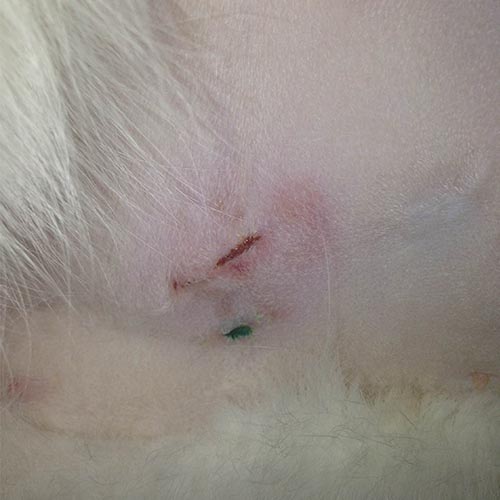What should a healing cat spay incision look like?
A healing cat spay incision should look like it is completely closed, with no open flesh exposed. There should also be no inflammation or bumps around the incision.
If you notice your cat is scratching at the spay incision, there is a good chance it is infected. Below I include pictures of normal spay incisions and cat spay incision infection pictures.
Cat Spay Healing Photos
Here are some pictures of cat spay incision healing pictures. The key to a healing cat spay is that there shouldn’t be any swelling or inflammation in or around the incision.
The first two cat spay incision pictures show the wound healing properly. Both incisions are closed up and there is no inflammation or bumps around the wound.
Pictures of normal spay incisions


Cat spay incision infection pictures
If your cat’s spay scar looks like one of these pictures below, you should consult your vet immediately. Signs of an infected scar include bumps on or below the skin, or a reopening of the scar.


In the first picture, you can notice a large swelling underneath the incision. In the second picture, the incision is beginning to open up.
There could be many reasons for this, but one of the main causes is too much activity after surgery. It is important that your cat takes it easy for a couple days following surgery. If your cats spay incision looks like one of these two photos, you should contact your vet immediately.
If you want to save money at the next pet visit, you should consider getting pet insurance for your cat. You can get a free quote below.
Products to help a cat spay incision heal
Cat Spay Incision Cream
If you suspect that your cat’s spay incision is not healing correctly, I would recommend Skin and Wound Spray.

Another great cream for a healing cat spay incision is the Skin and Wound gel. It is very effective because it hydrates the surface of your cat’s skin where it received the stiches.
This promotes growth of skin tissue around the wound, which helps prevent infection and soothes the wound so your cat won’t scratch at it. It also is non burn and non sting. You can buy it here on Chewy.
We recommend everyone get this Skin and Wound Gel or any other cream before the incision surgery, so that if there is any complication you can quickly put it on the wound. You can also use it whenever your cat gets a scratch.
What to do after a cat is spayed
After your cat is spayed, you should make sure that your cast rests for the next couple days. You should keep it indoors, limit its movement, and use the cat collar.
You should make sure to follow all of your vet’s instructions. Make sure your cat gets a lot of rest. If your cat isn’t sleeping well, you should check out my article on the best cat sedatives over the counter.
There is a chance your vet gives you a cone to put on your cat after the spay. This will prevent your cat from biting or scratching at the wound.
To learn more, you can check out my article on How Long to Keep Cone on Cat After Spay? If your cat just got spayed, you should also reference this article: how long to keep cat confined after spay.
The pictures for this article were provided by petsinstitches.
Why should you spay your cat?
You should spay your cat to:
- reduce the number of homeless cats
- prevent urinary infections and breast tumors in your cats
- improved behavior since your cat doesn’t go into heat, which can cause your cat to pee everywhere
- save money by not having to pay for your cat to care for a litter
If you decide to spay your cat, it is important that you monitor your cat’s spay incision to make sure it is not infected.


I really appreciate you touching on how a bulging incision should result in an immediate trip to the vet. My family wants to get a new kitten soon and we know that we have to spay her eventually. We want to be prepared so this article is really going to help us with this procedure.
Hi Joe,
I’m really glad you enjoyed the article. Good luck with the new kitten!